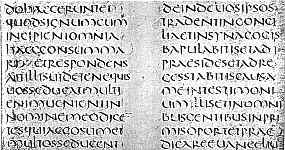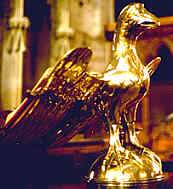 |
| Literacy
and the Church (2) |
|
While
we are here concentrating our minds on the literate culture of the church,
it must be borne constantly in mind that the church had a vigorous and
continuing oral culture. The liturgy
was spoken and sung aloud on a daily basis and the officiating clergy
would have known vast tracts of it of by heart. Sermons and preaching
were how the laity received their religious instruction, so that a priest,
deacon or reader had to be an oral performer. The congregation did not
have hymn books, prayer books or Bibles
to hand. They relied on the oral and visual culture of the church for
their learning, which the clergy had to provide. |
|
|
Books
for the readings were placed on lecterns like this medieval brass eagle, now
in Southwell Minster. |
|
The
pioneering clergy were missionaries and as such were active practitioners
of this oral culture. The earliest books which survive are gospels
or other Biblical extracts and works of liturgy, as well as the teachings
of the church fathers which formed the basis for sermons and preaching.
But the books were rare and precious and their copying was important to
the expansion of the church. The nodes of Christian expansion produced
scribes, but it
is difficult to know how literate these people were in our sense of that
word, and it is difficult to assess literacy in such a different culture
of the word. The oral culture of the church was in Latin, for the liturgy,
and in the vernacular,
for preaching and teaching. The literate culture was in Latin. |
 |
Some
early works were written in uncial
script, a laborious process in which each letter is made separately. Sometimes
the pages were in two columns and the letters ran on continuously; no
word spacing, no punctuation. The letters were fitted into the line without
regard for the ends of the words. This would seem to us to entail a mechanical
process of copying letter by letter. It would also seem to us to be very
difficult to read, certainly in the way that we might read a previously
unknown passage, such as the newspaper or a web site on medieval writing.
Did they conceptualise reading differently, or was this a memory aid for
passages that were already well known and had been learned orally? |
|
Section
from a few surviving leaves from a gospel in the Library of the monastery
of St Gall in Switzerland (Cod. 1394), from the late 5th or early 6th
centuries.The script is a very elegant uncial. |
|
|
Some
later works using majuscule
scripts, and some early ones for that matter, were written in a single
column across the page, and separation into individual words appeared.
However, there were still anomalies and one might query just how truly
literate these early scribes may have been. |
|
| This
segment is from the 8th century Vespasian Psalter (British Library, Cotton Vespasian
A1, f.31), by permission of the British Library. |
| In the example
above, red lines have been added to show the actual word breaks, showing
some idiosyncratic word spacing. There are words run together and separations
in the middle of words. The end of the word trepidabo in the first line
is actually written above it. It all seems a little painstaking and lacking
in real comprehension of the words as written. The work was produced in
Canterbury. |
|
The
Irish and Anglo-Saxon scribes who wrote in insular
half uncial or insular
minuscule very rapidly adopted the separation of words by spaces and
they developed forms of punctuation. Malcolm Parkes argues that this was because they primarily conceptualised Latin as a
written language and were steeped in a tradition of Latin grammar that
emphasised the conjugations and declensions of individual words. Their
word spacing was more irregular when they wrote in their own vernacular,
which they conceptualised in oral rather than graphic terms. Their intensive
use of abbreviation he also attributes to their conceptualisation of Latin
in graphic rather than spoken word terms. They did not heavily abbreviate
their vernacular works.
|
|
|
A
little grab from a copy of Priscian's grammar (Leiden University Library,
Cod. Lat. 67). (From
New Palaeographical
Society 1904)
The 9th century manuscript, in an Irish hand, shows word spacing, extensive
abbreviation and the meticulous recording of Latin grammar. |
| This
explanation is enticing and Parkes equates the developments of insular script
with the development of true legibility in what was, for the scribes and readers,
a second language. The need for true legibility implies true literacy. Like
many enticing explanations, the counterpoint to the argument is left somewhat
in limbo. Did the writers of continuous script, as found in prestige Classical
works as well as Christian volumes, have such a fluid concept of Latin that
they could actually read it with facility in this way? Or are these works
designed not for a literate usage, but as an extension of oral learning. |
 |
The
oral tradition of Christianity was not the same as oral traditions in the
field of arts or entertainment. Christianity was a religion of authority and
the authority was maintained through the integrity of written texts. Oral
teaching had to constantly refer back to those written texts. It was a religion
of the book. The didactic visual imagery in the churches and the oral ritual
and teaching were all derived from specified written texts. No matter how
much of their work the clergy learned by oral processes, and it was probably
much more than we can imagine with our utter dependence on the written word
for learning, literacy was essential to maintaining the accuracy and orthodoxy
of practice. Reading literacy in Latin became essential to all clergy. |
|
The
Biblical story of the crucifixion is told in stained glass in York Minster. |
continued  |
 previous
page previous
page |
 The
Concept of Literacy The
Concept of Literacy |
|
 |
 |
 |
 |
 |




